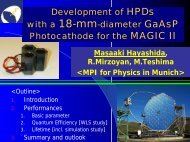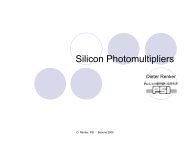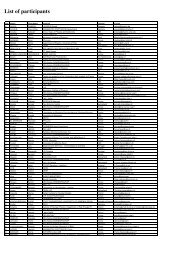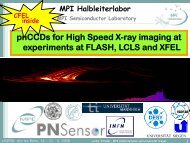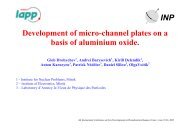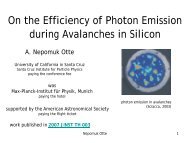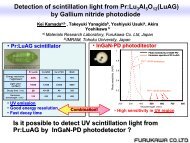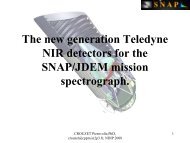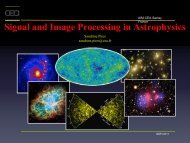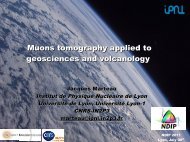Hydrogenated Black Diamond - NDIP 11
Hydrogenated Black Diamond - NDIP 11
Hydrogenated Black Diamond - NDIP 11
You also want an ePaper? Increase the reach of your titles
YUMPU automatically turns print PDFs into web optimized ePapers that Google loves.
<strong>Diamond</strong> UV photoconductive<br />
QuickTime and a TIFF (Uncompressed) decompressor are needed to see this picture.<br />
devices: high gain, high<br />
speed and solar-blind<br />
Stephane Curat, Ellepo Ambemou and<br />
Richard B Jackman<br />
Electronic Engineering<br />
& London Centre for Nanotechnology<br />
University College London
Acknowledgements<br />
Robert McKeag, Mike Whitfield, Stuart Lansley<br />
Olivier Gaudin, Bhaswar Baral, Haitao Ye<br />
UCL <strong>Diamond</strong> Group<br />
QuickTime and a TIFF (Uncompressed) decompressor are needed to see this picture.<br />
Philippe GA Bergonzo<br />
Useful discussions<br />
CEA, Saclay, France
• Hard, chemically resilient<br />
• Wide band gap (5.5eV)<br />
• High carrier mobilities<br />
Properties of <strong>Diamond</strong><br />
• Highest saturated carrier velocities<br />
• Highest electric field breakdown<br />
• strength<br />
• Highest thermal conductivity<br />
• Low dielectric constant<br />
• High electron ionisation energy<br />
• High atomic displacement energy<br />
• Highest acoustic wave velocity<br />
• Negative electron affinity<br />
Ideal diamond is<br />
a device engineers<br />
dream !<br />
Technology base<br />
immature<br />
Real diamond far<br />
from ideal<br />
QuickTime and a TIFF (Uncompressed) decompressor are needed to see this picture.
•<br />
Types of <strong>Diamond</strong>: Breakthrougth - µ & ρ values
External quantum efficiency<br />
Ec<br />
Ev<br />
Photoconductive devices<br />
Ratio of the flow of electrons per second from the device to the rate<br />
of generation<br />
Generation Recombination Trapping<br />
Eg<br />
G = {τ c (µ e + µ h ) V } / L 2<br />
Shallow traps enhance gain<br />
Recombination centres<br />
decrease it<br />
Long carrier lifetimes<br />
give poor response times<br />
QuickTime and a TIFF (Uncompressed) decompressor are needed to see this picture.
Photoconductive design<br />
• Interdigitated structure<br />
• Gold electrodes<br />
• 25µm pitch<br />
• Free standing CVD<br />
diamond<br />
(~100µm thick)<br />
Many regions are<br />
pseudo single crystal<br />
UV photodetectors<br />
QuickTime and a TIFF (Uncompressed) decompressor are needed to see this picture.
• As fabricated device<br />
responsive in the<br />
visible<br />
• Treated device shows<br />
true ‘visible blindness’<br />
• Sharp cut off at band<br />
edge (225nm)<br />
Spectral response<br />
Responsivity (arbitary units)<br />
1E+00<br />
1E-01<br />
1E-02<br />
1E-03<br />
1E-04<br />
1E-05<br />
1E-06<br />
1E-07<br />
1E-08<br />
as fabricated<br />
after gas treatment<br />
200 400 600 800<br />
Wavelength (nm)<br />
QuickTime and a TIFF (Uncompressed) decompressor are needed to see this picture.
Varying the grain size<br />
Type III:<br />
10-30µm grains<br />
Type II:<br />
20-40µm grains<br />
Type I:<br />
40-60µm grains<br />
Identically treated<br />
devices<br />
Differing film<br />
thicknesses, leading<br />
to variation in grain size<br />
QuickTime and a TIFF (Uncompressed) decompressor are needed to see this picture.
Type I:<br />
40-60µm grains<br />
Gain level vs grain size<br />
Type III:<br />
10-30µm grains<br />
Field strength 40- 4x10 4 V/cm<br />
High levels of gain<br />
Can be realised<br />
Implies increased<br />
carrier lifetime<br />
in large grain material<br />
QuickTime and a TIFF (Uncompressed) decompressor are needed to see this picture.
Device speed: 193nm laser pulse detection<br />
15ns pulse<br />
1T - SLOW<br />
5T - FAST<br />
No pulse<br />
‘build-up’<br />
Can be used for MHz operation<br />
Can ‘engineer’ speed as well<br />
Normalised Voltage<br />
1.2<br />
1<br />
0.8<br />
0.6<br />
0.4<br />
0.2<br />
0<br />
1 treatment<br />
5 treatments<br />
-0.2<br />
-100 0 100 200 300 400 500<br />
Time (ns)<br />
(a)<br />
QuickTime and a TIFF (Uncompressed) decompressor are needed to see this picture.
Damage studies - effect on device speed<br />
<strong>Diamond</strong> is<br />
considered<br />
radiation ‘hard’<br />
BUT<br />
Excimer laser<br />
Radiation (193nm)<br />
causes damage<br />
to detectors<br />
(fluence ~ 10mJcm -2 )<br />
normalised response<br />
1.2<br />
1.0<br />
0.8<br />
0.6<br />
0.4<br />
0.2<br />
0.0<br />
-0.2<br />
1T Device<br />
10^4 pulses<br />
10^5 pulses<br />
10^6 pulses<br />
10^7 pulses<br />
VPD<br />
-6.0x10 -8 -4.0x10 -8 -2.0x10 -8 0.0 2.0x10 -8 4.0x10 -8 6.0x10 -8 8.0x10 -8 1.0x10 -7<br />
time (s)<br />
(a)<br />
QuickTime and a TIFF (Uncompressed) decompressor are needed to see this picture.
Five times<br />
Treated device<br />
• As fast as<br />
VPD<br />
• Not degraded<br />
by 10 7 pulses<br />
• Priming effect<br />
Multiply treated devices<br />
normalised response<br />
1.2<br />
1.0<br />
0.8<br />
0.6<br />
0.4<br />
0.2<br />
0.0<br />
-0.2<br />
5T Device<br />
10^4 pulses<br />
10^5 pulses<br />
10^6 pulses<br />
10^7 pulses<br />
VPD<br />
-6.0x10 -8 -4.0x10 -8 -2.0x10 -8 0.0 2.0x10 -8 4.0x10 -8 6.0x10 -8 8.0x10 -8 1.0x10 -7<br />
Time (s)<br />
(b)<br />
QuickTime and a TIFF (Uncompressed) decompressor are needed to see this picture.
Effect on device dark current<br />
Singly treated<br />
devices show a<br />
considerable increase<br />
Multiply treated<br />
devices do not!<br />
dark current (A)<br />
10 -6<br />
10 -7<br />
10 -8<br />
10 -9<br />
10 -10<br />
10 -<strong>11</strong><br />
10 -12<br />
10 -13<br />
10 0<br />
1T device<br />
10 1<br />
5T device<br />
10 2<br />
10 3<br />
10 4<br />
pulse exposure<br />
10 5<br />
10 6<br />
10 7<br />
QuickTime and a TIFF (Uncompressed) decompressor are needed to see this picture.
Imaging arrays - do they work ?<br />
~3 mm<br />
~150 µm<br />
Common<br />
12345678<br />
150µm pixels<br />
Suitable for beam<br />
tracking and<br />
profiling of<br />
expanded beams<br />
Higher resolution<br />
devices under<br />
test<br />
QuickTime and a TIFF (Uncompressed) decompressor are needed to see this picture.
Imaging arrays - yes, they do !<br />
4<br />
3<br />
2<br />
1<br />
0<br />
-1<br />
-5 10 -8<br />
0 5 10 -8<br />
9V 0.1mJcm-2<br />
Time (s) QuickTime<br />
1 10 -7<br />
1<br />
2<br />
3<br />
4<br />
1.5 10 -7<br />
5<br />
6<br />
7<br />
8<br />
2 10 -7<br />
and a TIFF (Uncompressed) decompressor are needed to see this picture.
Imaging arrays - excellent uniformity<br />
5<br />
4<br />
3<br />
2<br />
1<br />
0<br />
-1<br />
-2<br />
-5 10 -8<br />
Single Pulse on elements 6 & 7<br />
0 5 10 -8<br />
Fluence ~1mJcm -2<br />
Time (s)<br />
1 10 -7<br />
1.5 10 -7<br />
Array_6<br />
Array_7<br />
2 10 -7<br />
QuickTime and a TIFF (Uncompressed) decompressor are needed to see this picture.
Response of Vacuum Photodiode<br />
to F Laser 2 Laser Radiation<br />
2<br />
Response (V)<br />
14<br />
12<br />
10<br />
8<br />
6<br />
4<br />
2<br />
Red Laser<br />
Emission<br />
0<br />
-1E-007 -5E-008 0 5E-008 1E-007 1.5E-007<br />
157nm - detector needed Time by (s) semiconductor<br />
industry<br />
QuickTime and a TIFF (Uncompressed) decompressor are needed to see this picture.
Temporal Response of<br />
<strong>Diamond</strong> Detector to F Laser 2 Laser Radiation<br />
2<br />
<strong>Diamond</strong> detectors<br />
a good 157nm<br />
solution<br />
QuickTime and a TIFF (Uncompressed) decompressor are needed to see this picture.
Imaging Performance at 157nm<br />
130nm 120nm<br />
Isolated and 1:1 lines<br />
Photoresist: 60nm thick Shipley XP-98248-S optimized for use at 248nm<br />
QuickTime and a TIFF (Uncompressed) decompressor are needed to see this picture.
What have we achieved ?<br />
The application of post-growth treatments<br />
have enabled us to ‘engineer’ the properties<br />
of the devices<br />
• Spectral characteristics<br />
• Speed<br />
• Gain<br />
• Radiation hardness<br />
• Dark current<br />
Changes are very stable QuickTime<br />
and a TIFF (Uncompressed) decompressor are needed to see this picture.
Concluding Remarks<br />
• Relatively low cost free-standing CVD<br />
grown polycrystalline diamond can be<br />
• engineered to produce highly effective<br />
deep UV detectors<br />
Current price of 50mm diamond wafer<br />
~$2000 (sufficient for ~100 3x3mm devices)<br />
• Gem market is causing new sources of<br />
single crystal material to emerge<br />
May enable even higher performance<br />
levels at realistic cost<br />
QuickTime and a TIFF (Uncompressed) decompressor are needed to see this picture.



